Module 11 Unit 2 教学课件-外语教研版中学英语七年级下
文档属性
| 名称 | Module 11 Unit 2 教学课件-外语教研版中学英语七年级下 | 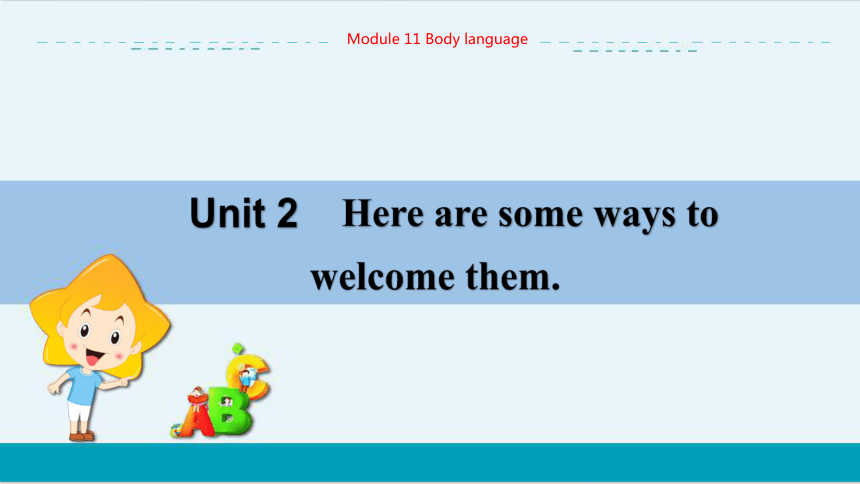 | |
| 格式 | pptx | ||
| 文件大小 | 3.5MB | ||
| 资源类型 | 试卷 | ||
| 版本资源 | 外研版 | ||
| 科目 | 英语 | ||
| 更新时间 | 2024-02-21 19:05:49 | ||
图片预览




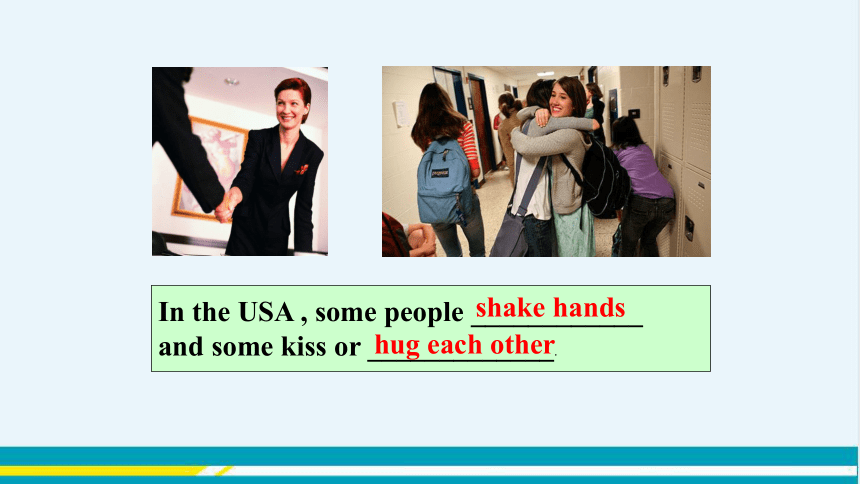
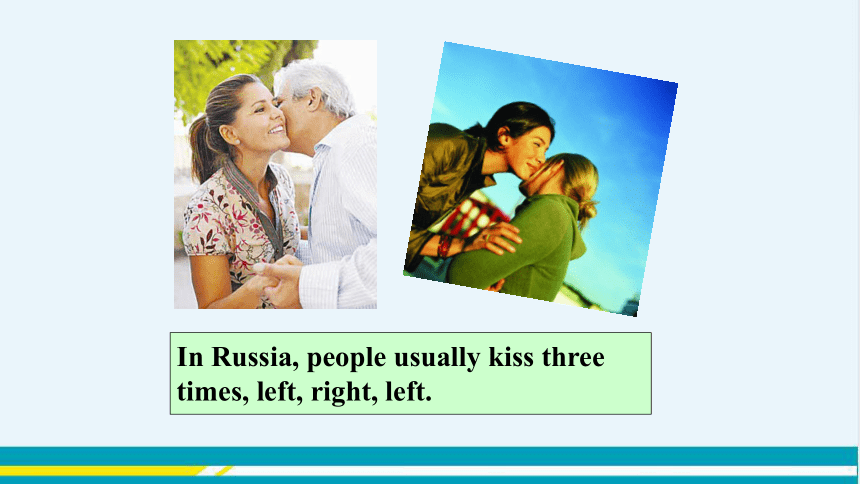
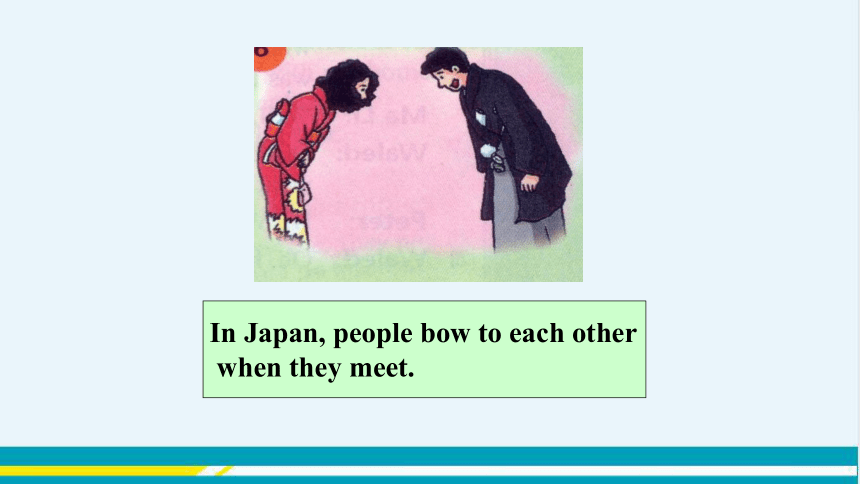


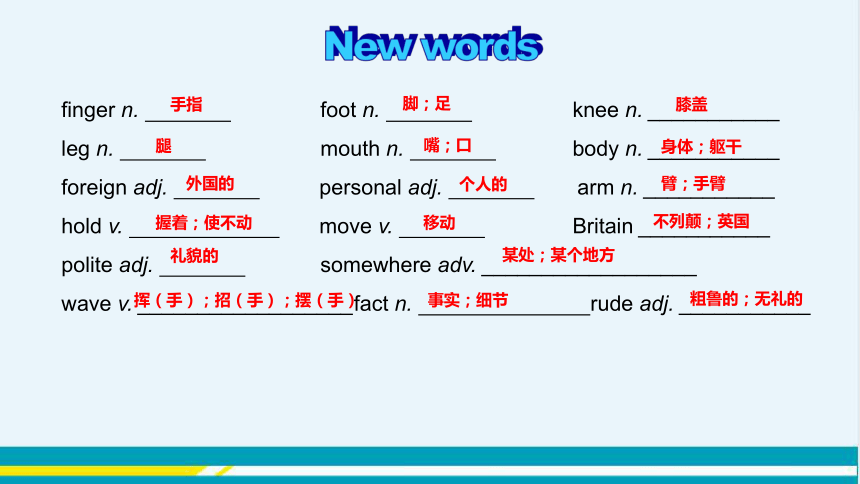
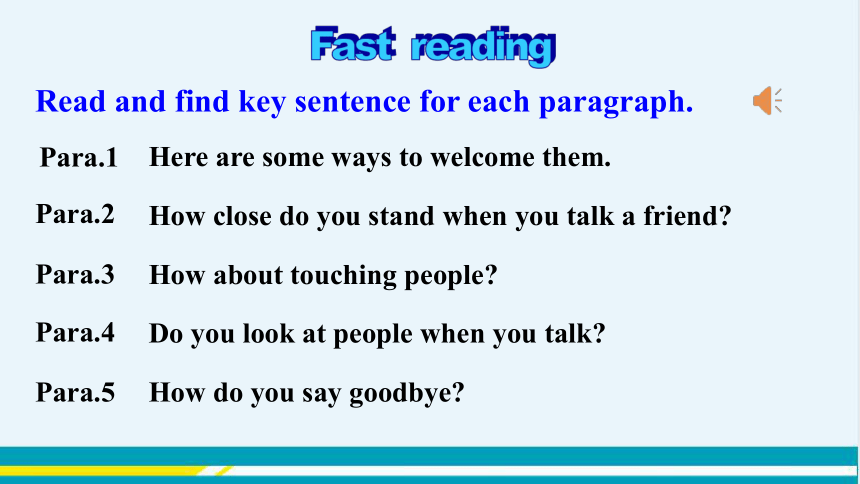

文档简介
(共35张PPT)
Unit 2 Here are some ways to
welcome them.
Module 11 Body language
学 习 目 标
1
3
2
3
学习并掌握本单元单词和短语:finger, foot, knee, leg, mouth, body, foreign, personal, arm, hold, move, Britain, polite, somewhere, wave, fact, rude, North American, arm in arm, South American, not at all, in fact。
学习并掌握本单元重点句型:(1) …here are some ways to welcome them.
(2) Give them more personal space.
(3) Chinese girls often walk arm in arm with their friends.
(4) South Americans sometimes hold your arm when they talk to you, so you can’t move away!
(5) But in Britain many people don’t like other people to touch them at all.
(6) In fact, it’s very rude!
能用祈使句给对方提出指示和建议。
能运用祈使句写学校规则。
课 堂 导 入
In India, people greet each other by ______
their hands _______ and ________________.
nod their heads
putting
together
Do you remember the different ways of greeting around the world
In New Zealand, Maori people greet each
other by________________.
touching noses
In the USA , some people ____________
and some kiss or _____________.
shake hands
hug each other
In Russia, people usually kiss three
times, left, right, left.
In Japan, people bow to each other
when they meet.
In China,people often shake hands
and smile.
Can you say the part of your body
eye
finger
foot
knee
leg
mouth
课 堂 学 习
finger n. foot n. knee n. ___________
leg n. mouth n. body n. ___________
foreign adj. personal adj. arm n. ___________
hold v. move v. Britain ___________
polite adj. somewhere adv. __________________
wave v. __________________fact n. rude adj. ___________
New words
手指
脚;足
膝盖
腿
嘴;口
身体;躯干
外国的
个人的
臂;手臂
握着;使不动
移动
不列颠;英国
礼貌的
某处;某个地方
挥(手);招(手);摆(手)
事实;细节
粗鲁的;无礼的
Fast reading
Read and find key sentence for each paragraph.
Para.1
How close do you stand when you talk a friend
How about touching people
Do you look at people when you talk
How do you say goodbye
Here are some ways to welcome them.
Para.2
Para.3
Para.4
Para.5
Careful reading
It is polite to stand close to people in the ___________.
It is rude to stand close to people in ______________.
Give them more ____________ space.
We can’t stand too close to them.
Middle East
North America
Read Paragraph 2 and fill in the blanks.
personal
Touching people Chinese girls
South Americans
British
B.Like walking arm in arm.
A.Sometimes like holding your arm.
C.Don’t like other people to touch them at all.
Read Paragraph 3 and choose the right answers.
A
C
B
Read Paragraph 4 and answer the questions.
1. Do the British look at each other when they talk
2.Is it always polite to look at each other when you talk
No, it isn’t.
Yes, they do.
In Britain and the US, people usually look at each other when they talk.
In some places, it isn’t polite to look at people when you talk, but in other countries it isn’t polite to look somewhere else.
1. Is body language the same in different countries
2. Is it all right to stand close to people in the Middle East
3. Do the British like touching people
4. Do Americans look at people when they talk
5. Do people in Greece wave goodbye
Answer the questions:
No, it isn’t.
Yes, it is.
No, they don’t.
Yes, they do.
No, they don’t.
3 Check the body language you can use in different
countries and places.
Stand close Touch each other Look at people when talking
Britain
Middle East
South America
US
√
√
√
√
North American arm in arm
South American not at all
in fact stand close to _______________
the Middle East wave to say goodbye _______________
personal space move away _______________
Read the phrases in the passage and translate them into Chinese.
北美人
臂挽臂地
南美人
一点也不
事实上
站得离……近
挥手告别
中东
个人空间
搬走;移开
Language points
1.Here are some ways to welcome them.
这儿有一些欢迎他们的方式。
here 为副词,表示“在这里”。
Here is/are“这儿是……, 这儿有……”。
Ann is not here. 安不在这儿。
Is everyone here today 今天大家都到了吗?
Are we all here 我们都到了吗?
Here are some apples.(相当于 Some apples are here.)这里有一些苹果。
【注意】当主语是代词时,主谓不倒装。
Here it comes. 它来了
2. Give them more personal space.给他们更多的私人空间。
personal 为形容词,意为“个人的;私人的”
Don't question me about my personal business!
不要问我私事!
Be careful how you start the personal computer.
要注意怎样启动个人计算机。
This is my personal problem.
这是我个人的问题。
3. Chinese girls often walk arm in arm with their friends.
中国女孩经常和她们的朋友臂挽臂地走路。
arm in arm 臂挽臂地
We often walk along the street arm in arm.
我们经常臂挽臂地沿着街走。
I saw them go shopping arm in arm last weekend.
上周末我看到他们臂挽臂地去购物了。
4. South Americans sometimes hold your arm when they talk to you,so you can’t move away! 南美人和你交谈时,有时会抓着你的手臂,所以你就走不开了!
hold v. 握住,抓住
hold one’s arm 抓着某人的手臂
The little baby got to the chair by holding her mother’s arm.
这个小女孩抓着妈妈的手臂坐上了椅子。
He helped Grandma Wu up to her feet by holding her arm.
他搀着吴奶奶的手臂帮她站起身来。
5. But in Britain many people don’t like other people to touch them at all.但是在英国,许多人一点也不喜欢别人碰他们。
not...at all 意为“一点也不……,根本不……”,not 常置于连系动词 be、情态动词或
助动词之后,at all 则放在句末。
I don’t like math at all. 我一点也不喜欢数学。
(1)用于回答感谢,意为“不用谢;不客气”。
A:Thanks for helping me. 谢谢你帮助我。
B:Not at all. I enjoyed it. 别客气,很高兴能帮你。
A:Thank you very much. 非常感谢你。
B:Not at all. 不用谢。
(2)用于回答带有感谢性质的客套话,意为“没什么”。
A:You are very kind. 你真好。
B:Not at all. 没什么。
(3)用于回答道歉,意为“没关系”。
A:I’m sorry I’m late. 对不起,我迟到了。
B:Oh,not at e in,please! 噢,没关系,请进来!
A:I’m sorry to keep you waiting. 对不起,让你久等了。
B:Oh,not at all. I’ve been here only a few minutes.
哦,没关系,我也刚到几分钟。
not at all 用法小结:
【拓展】
(4)用来表示否定(是 no 的加强说法), “一点也不;完全不”。
A:Are you busy 你忙吗?
B:Not at all. 一点也不忙。
A:Is it difficult to study English 英语难学吗?
B:Not at all. 一点也不难。
A:I’ll be away on a business trip. Would you mind helping me look after my cat 我要去出差,你介意帮我照看我的猫吗?
B:Not at all. I’ll be happy to. 一点也不介意,我很乐意。
6. In fact, it’s very rude!事实上,这很粗鲁!
(1) in fact“事实上;其实”,通常放在句首。
In fact, I think an old car is better than none.
事实上,我认为有一辆旧车总比没车强。
He doesn’t mind. In fact, he is very pleased.
他不介意。事实上,他很高兴。
In fact,I think you’re right. 其实,我认为你是对的。
(2) rude为形容词,意为“粗鲁的,无礼的”,与 impolite 同义。
Don’t be so rude to your parents! 别对你的父母这么没礼貌!
It’s very rude of her to leave without telling us.
她不向我们打声招呼就走了,这是非常不礼貌的。
It is rude to spit in public. 在公开场合吐痰是粗鲁的。
4 Complete the passage with the words from the box.
Britain fact foreign hold move personal
polite rude someone wave
Lingling: People from _______ countries have different
body language from us. In _______ ,people don’t like to
touch other people, but in South America they like to
_____on to you so you can’t _____away. Remember
to give _______ from North America lots of _______
space. In some countries it isn’t ______ to look at people
when you talk. And it isn’t polite to______ goodbye in
Greece. In ______,it’s quite _____ !
fact
Britain
hold
move
someone
personal
polite
wave
foreign
rude
Writing
5 Work in groups. Talk about your class rules.
(1) — Shall we stand up when we answer a question in class
— Yes, we shall.
(2) — What do you do when you want to ask a question during class
— I always put up my hand first.
6 Make a list of class rules for new students in
your school.
Stand up when you answer a question in class.
Don’t be late for class.
Be polite to the teacher.
Don’t eat food in class.
…
课 堂 达 标
I.根据汉语提示完成句子。
1. _______ (事实上), we use body language every day.
2. Please _________ (小心)! There is a car in front of you.
3. These ________________ (南美人) can speak Chinese very well.
In fact
be careful
South Americans
4. Those girls walked into the clothes shop
___________ (臂挽臂地).
5. Mike ________ like meat _____ (一点也不).
arm in arm
doesn’t
at all
II. 单项选择。
1._____ the door. It’s cold outside.
A. Opening B. Don’t open
C. Not open D. To open
2.Hi,Rose.Let’s_____ lunch together.
A.to have B. has C. having D. have
3.Please ______ in the library.
A. quiet B. to quite C. be quiet D. being quiet
B
D
C
4. Mr. Black is living ________the post office.
A.close at B.close to
C.closely in D.closed with
5. —It's a little cold. Would you mind closing thewindow
— ________.
A.Forget it B.No,you can't
C.Not at all D.Of course
B
C
1. Retell the passage:Body language around the world.
2.Review the words and expressions of Unit 2.
Homework
Thank you !
Unit 2 Here are some ways to
welcome them.
Module 11 Body language
学 习 目 标
1
3
2
3
学习并掌握本单元单词和短语:finger, foot, knee, leg, mouth, body, foreign, personal, arm, hold, move, Britain, polite, somewhere, wave, fact, rude, North American, arm in arm, South American, not at all, in fact。
学习并掌握本单元重点句型:(1) …here are some ways to welcome them.
(2) Give them more personal space.
(3) Chinese girls often walk arm in arm with their friends.
(4) South Americans sometimes hold your arm when they talk to you, so you can’t move away!
(5) But in Britain many people don’t like other people to touch them at all.
(6) In fact, it’s very rude!
能用祈使句给对方提出指示和建议。
能运用祈使句写学校规则。
课 堂 导 入
In India, people greet each other by ______
their hands _______ and ________________.
nod their heads
putting
together
Do you remember the different ways of greeting around the world
In New Zealand, Maori people greet each
other by________________.
touching noses
In the USA , some people ____________
and some kiss or _____________.
shake hands
hug each other
In Russia, people usually kiss three
times, left, right, left.
In Japan, people bow to each other
when they meet.
In China,people often shake hands
and smile.
Can you say the part of your body
eye
finger
foot
knee
leg
mouth
课 堂 学 习
finger n. foot n. knee n. ___________
leg n. mouth n. body n. ___________
foreign adj. personal adj. arm n. ___________
hold v. move v. Britain ___________
polite adj. somewhere adv. __________________
wave v. __________________fact n. rude adj. ___________
New words
手指
脚;足
膝盖
腿
嘴;口
身体;躯干
外国的
个人的
臂;手臂
握着;使不动
移动
不列颠;英国
礼貌的
某处;某个地方
挥(手);招(手);摆(手)
事实;细节
粗鲁的;无礼的
Fast reading
Read and find key sentence for each paragraph.
Para.1
How close do you stand when you talk a friend
How about touching people
Do you look at people when you talk
How do you say goodbye
Here are some ways to welcome them.
Para.2
Para.3
Para.4
Para.5
Careful reading
It is polite to stand close to people in the ___________.
It is rude to stand close to people in ______________.
Give them more ____________ space.
We can’t stand too close to them.
Middle East
North America
Read Paragraph 2 and fill in the blanks.
personal
Touching people Chinese girls
South Americans
British
B.Like walking arm in arm.
A.Sometimes like holding your arm.
C.Don’t like other people to touch them at all.
Read Paragraph 3 and choose the right answers.
A
C
B
Read Paragraph 4 and answer the questions.
1. Do the British look at each other when they talk
2.Is it always polite to look at each other when you talk
No, it isn’t.
Yes, they do.
In Britain and the US, people usually look at each other when they talk.
In some places, it isn’t polite to look at people when you talk, but in other countries it isn’t polite to look somewhere else.
1. Is body language the same in different countries
2. Is it all right to stand close to people in the Middle East
3. Do the British like touching people
4. Do Americans look at people when they talk
5. Do people in Greece wave goodbye
Answer the questions:
No, it isn’t.
Yes, it is.
No, they don’t.
Yes, they do.
No, they don’t.
3 Check the body language you can use in different
countries and places.
Stand close Touch each other Look at people when talking
Britain
Middle East
South America
US
√
√
√
√
North American arm in arm
South American not at all
in fact stand close to _______________
the Middle East wave to say goodbye _______________
personal space move away _______________
Read the phrases in the passage and translate them into Chinese.
北美人
臂挽臂地
南美人
一点也不
事实上
站得离……近
挥手告别
中东
个人空间
搬走;移开
Language points
1.Here are some ways to welcome them.
这儿有一些欢迎他们的方式。
here 为副词,表示“在这里”。
Here is/are“这儿是……, 这儿有……”。
Ann is not here. 安不在这儿。
Is everyone here today 今天大家都到了吗?
Are we all here 我们都到了吗?
Here are some apples.(相当于 Some apples are here.)这里有一些苹果。
【注意】当主语是代词时,主谓不倒装。
Here it comes. 它来了
2. Give them more personal space.给他们更多的私人空间。
personal 为形容词,意为“个人的;私人的”
Don't question me about my personal business!
不要问我私事!
Be careful how you start the personal computer.
要注意怎样启动个人计算机。
This is my personal problem.
这是我个人的问题。
3. Chinese girls often walk arm in arm with their friends.
中国女孩经常和她们的朋友臂挽臂地走路。
arm in arm 臂挽臂地
We often walk along the street arm in arm.
我们经常臂挽臂地沿着街走。
I saw them go shopping arm in arm last weekend.
上周末我看到他们臂挽臂地去购物了。
4. South Americans sometimes hold your arm when they talk to you,so you can’t move away! 南美人和你交谈时,有时会抓着你的手臂,所以你就走不开了!
hold v. 握住,抓住
hold one’s arm 抓着某人的手臂
The little baby got to the chair by holding her mother’s arm.
这个小女孩抓着妈妈的手臂坐上了椅子。
He helped Grandma Wu up to her feet by holding her arm.
他搀着吴奶奶的手臂帮她站起身来。
5. But in Britain many people don’t like other people to touch them at all.但是在英国,许多人一点也不喜欢别人碰他们。
not...at all 意为“一点也不……,根本不……”,not 常置于连系动词 be、情态动词或
助动词之后,at all 则放在句末。
I don’t like math at all. 我一点也不喜欢数学。
(1)用于回答感谢,意为“不用谢;不客气”。
A:Thanks for helping me. 谢谢你帮助我。
B:Not at all. I enjoyed it. 别客气,很高兴能帮你。
A:Thank you very much. 非常感谢你。
B:Not at all. 不用谢。
(2)用于回答带有感谢性质的客套话,意为“没什么”。
A:You are very kind. 你真好。
B:Not at all. 没什么。
(3)用于回答道歉,意为“没关系”。
A:I’m sorry I’m late. 对不起,我迟到了。
B:Oh,not at e in,please! 噢,没关系,请进来!
A:I’m sorry to keep you waiting. 对不起,让你久等了。
B:Oh,not at all. I’ve been here only a few minutes.
哦,没关系,我也刚到几分钟。
not at all 用法小结:
【拓展】
(4)用来表示否定(是 no 的加强说法), “一点也不;完全不”。
A:Are you busy 你忙吗?
B:Not at all. 一点也不忙。
A:Is it difficult to study English 英语难学吗?
B:Not at all. 一点也不难。
A:I’ll be away on a business trip. Would you mind helping me look after my cat 我要去出差,你介意帮我照看我的猫吗?
B:Not at all. I’ll be happy to. 一点也不介意,我很乐意。
6. In fact, it’s very rude!事实上,这很粗鲁!
(1) in fact“事实上;其实”,通常放在句首。
In fact, I think an old car is better than none.
事实上,我认为有一辆旧车总比没车强。
He doesn’t mind. In fact, he is very pleased.
他不介意。事实上,他很高兴。
In fact,I think you’re right. 其实,我认为你是对的。
(2) rude为形容词,意为“粗鲁的,无礼的”,与 impolite 同义。
Don’t be so rude to your parents! 别对你的父母这么没礼貌!
It’s very rude of her to leave without telling us.
她不向我们打声招呼就走了,这是非常不礼貌的。
It is rude to spit in public. 在公开场合吐痰是粗鲁的。
4 Complete the passage with the words from the box.
Britain fact foreign hold move personal
polite rude someone wave
Lingling: People from _______ countries have different
body language from us. In _______ ,people don’t like to
touch other people, but in South America they like to
_____on to you so you can’t _____away. Remember
to give _______ from North America lots of _______
space. In some countries it isn’t ______ to look at people
when you talk. And it isn’t polite to______ goodbye in
Greece. In ______,it’s quite _____ !
fact
Britain
hold
move
someone
personal
polite
wave
foreign
rude
Writing
5 Work in groups. Talk about your class rules.
(1) — Shall we stand up when we answer a question in class
— Yes, we shall.
(2) — What do you do when you want to ask a question during class
— I always put up my hand first.
6 Make a list of class rules for new students in
your school.
Stand up when you answer a question in class.
Don’t be late for class.
Be polite to the teacher.
Don’t eat food in class.
…
课 堂 达 标
I.根据汉语提示完成句子。
1. _______ (事实上), we use body language every day.
2. Please _________ (小心)! There is a car in front of you.
3. These ________________ (南美人) can speak Chinese very well.
In fact
be careful
South Americans
4. Those girls walked into the clothes shop
___________ (臂挽臂地).
5. Mike ________ like meat _____ (一点也不).
arm in arm
doesn’t
at all
II. 单项选择。
1._____ the door. It’s cold outside.
A. Opening B. Don’t open
C. Not open D. To open
2.Hi,Rose.Let’s_____ lunch together.
A.to have B. has C. having D. have
3.Please ______ in the library.
A. quiet B. to quite C. be quiet D. being quiet
B
D
C
4. Mr. Black is living ________the post office.
A.close at B.close to
C.closely in D.closed with
5. —It's a little cold. Would you mind closing thewindow
— ________.
A.Forget it B.No,you can't
C.Not at all D.Of course
B
C
1. Retell the passage:Body language around the world.
2.Review the words and expressions of Unit 2.
Homework
Thank you !
同课章节目录
- Module 1 Lost and found
- Unit 1 Whose bag is this?
- Unit 2 Are they yours?
- Unit 3 Language in use
- Module 2 What can you do ?
- Unit 1 I can play the piano
- Unit 2 I can run really fast
- Unit 3 Language in use
- Module 3 Making plans
- Unit 1 What are you going to do at the weekends?
- Unit 2 We're going to cheer the players.
- Unit 3 Language in use
- Module 4 Life in the future
- Unit 1 Everyone will study at home
- Unit 2 Every family will have a small plane.
- Unit 3 Language in use
- Module 5 Shopping
- Unit 1 What can I do for you?
- Unit 2 You can buy everything on the Internet
- Unit 3 Language in use
- Module 6 Around town
- Unit 1 Could you tell me how to get to the Nationa
- Unit 2 The London Eye is on your right.
- Unit 3 Language in use
- Revision module A
- Module 7 My past life
- Unit 1 I was born in a small village.
- Unit 2 I was born in Quincy.
- Unit 3 Language in use
- Module 8 Story time
- Unit 1 Once upon a time….
- Unit 2 Goldilocks hurried out of the house.
- Unit 3 Language in use
- Module 9 Life history
- Unit 1 He left school and began work at the age of
- Unit 2 He decided to be an actor.
- Unit 3 Language in use
- Module 10 A holiday journey
- Unit 1 What did you do?
- Unit 2 This morning we took a walk.
- Unit 3 Language in use
- Module 11 Body language
- Unit 1 They touch noses!
- Unit 2 Here are some ways to welcome them.
- Unit 3 Language in use
- Module 12 Western music
- Unit 1 It's so beautiful!
- Unit 2 Vienna is the centre of European classical
- Unit 3 Language in use
- Revision module B
